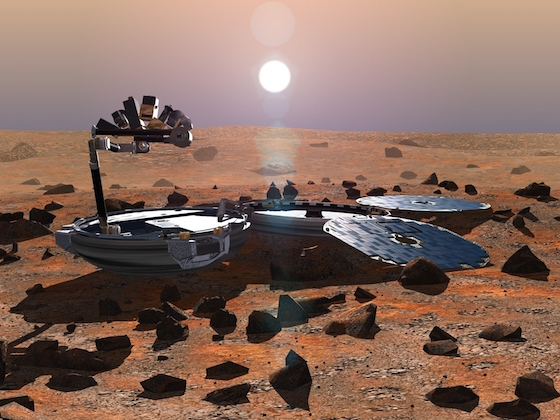Scientists solve mystery of Beagle 2 Mars lander
Scientists may have solved the mystery of what happened to the ill-fated Mars lander Beagle 2 thanks to an innovative research technique.
The probe was discovered on the Red Planet in November 2014 but uncertainty surrounded what had caused its failure to communicate with Earth.

Now, a collaboration between De Montfort University Leicester (DMU) and the University of Leicester has used 3D modelling technology to reveal for the first time that Beagle 2 did not crash land as previously thought.
Instead analysis by DMU’s visualisation specialist Teodora Kuzmanova found Beagle 2 deployed at least three of the solar panels it was supposed to after touching down on the planet’s surface.
It may be that the antenna may have been transmitting as planned - but the signal could not get through because the fourth panel had not opened properly.
Beagle 2 was successfully ejected from ESA’s Mars Express spacecraft on 19 December 2003 but failed to send a signal on Christmas Day - its scheduled landing day on Mars.
It was presumed lost until over a decade later when the mystery of what happened to the mission was solved when images taken by NASA’s Mars Reconnaissance Orbiter (MRO) recorded it on the surface of the planet.
However, because of the MRO camera resolution and the size of Beagle 2 it was not clear what had happened to it.
A video made explaining the Beagle 2 project when the images of the lander was found in 2014 - it was this finding that led to the DMU researchProfessor Mark Sims, former Beagle 2 Mission Manager and Professor of Astrobiology and Space Instrumentation at the University of Leicester came up with the concept of “reflection analysis” - of matching simulated and real images of Beagle 2.
The technique is based on simulating possible configurations of the lander on the surface and comparing the light of the Sun reflected by the simulated lander with the unprocessed images available from the HiRISE camera at a number of different sun angles.
Professor Sims turned to a team at DMU to realise his concept. Commercially available software used for 3D modelling, animation, visual effects and simulation design was adapted to enable this analysis.
Nick Higgett leader of the DMU simulation team said: “This has been an exciting collaboration with the University of Leicester’s Space Research Centre.
“The De Montfort team were responsible for all the 3D simulation work to test the reflection analysis concept.
“In order to do this, our visualisation specialist Teodora Kuzmanova had to create a physically accurate 3D model of the Beagle 2 Mars Lander with surfaces that would accurately reflect virtual sunlight.
“The angle of the sun had to be simulated along with position of a virtual camera that could take pictures equivalent to NASA’s Reconnaissance Orbiter. Finally these images had to be pixelated to match the resolution of the Orbiter’s images.
“We are delighted to say that we have gone way beyond this original plan to reach this exciting conclusion that Beagle 2 did not crash but landed and probably deployed most of its panels. Hopefully these results help to solve a long held mystery and will benefit any future missions to Mars.”
Professor Mark Sims praised the DMU team for making his idea a reality.
He added: “The work shows frustratingly that Beagle 2 came so close to working as intended on Mars.
“This unique University collaboration between space scientists and digital designers allowed this reflection analysis concept to be put into practice and tested and ultimately produce these exciting results.”
This work confirmed that antenna transmission would probably have been hampered by one of the panels failing to unfold correctly, confirming the previously supposed theory.
Mr Higgett said it was as close to a definitive explanation as would be possible without landing on the planet itself.
Beagle 2, a collaboration between industry and academia, would have delivered world-class science from the surface of the Red Planet. It was sent there to search for signs of life by analysing soil for organic molecules.
Many UK academic groups and industrial companies contributed to Beagle 2. Its enthusiastic leader was Professor Colin Pillinger from the Open University who died in May 2014 before the fate of the lander was revealed.
Others who also died in 2014 and provided major contributions to Beagle 2 were Professor George Fraser of the University of Leicester and Professor David Barnes of Aberystwyth University.
Posted on: Friday 11 November 2016